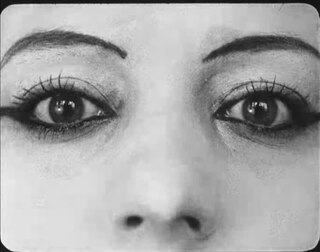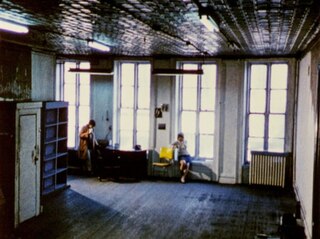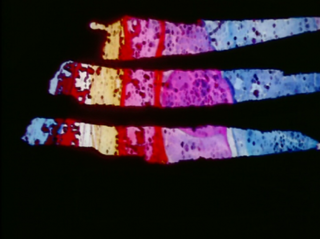Related Research Articles

A Movie is a 1958 experimental collage film by American artist Bruce Conner. It combines pieces of found footage taken from various sources such as newsreels, soft-core pornography, and B movies, all set to a score featuring Ottorino Respighi's Pines of Rome.
Pull My Daisy is a 1959 American short film directed by Robert Frank and Alfred Leslie, and adapted by Jack Kerouac from the third act of his play, Beat Generation.
Serene Velocity is a 1970 American experimental short film directed by Ernie Gehr. Gehr filmed it in the basement hallway of a Binghamton University academic building, using a static camera position and changing only the focal length of the camera. It is recognized as a key work of structural filmmaking and has been inducted into the U.S. National Film Registry.

Shadows is a 1959 American independent drama film directed by John Cassavetes about race relations during the Beat Generation years in New York City. The film stars Ben Carruthers, Lelia Goldoni, and Hugh Hurd as three black siblings, though only one of them is dark-skinned enough to be considered African American. The film was initially shot in 1957 and shown in 1958, but a poor reception prompted Cassavetes to rework it in 1959. Promoted as a completely improvisational film, it was intensively rehearsed in 1957, and in 1959 it was fully scripted.

Jonas Mekas was a Lithuanian-American filmmaker, poet, and artist who has been called "the godfather of American avant-garde cinema". Mekas' work has been exhibited in museums and at festivals worldwide. Mekas was active in New York City, where he co-founded Anthology Film Archives, The Film-Makers' Cooperative, and the journal Film Culture. He was also the first film critic for The Village Voice.

Scorpio Rising is a 1963 American experimental short film shot, edited, co-written and directed by Kenneth Anger, and starring Bruce Byron as Scorpio. Loosely structured around a prominent soundtrack of 1960s pop music, it follows a group of bikers preparing for a night out.

Experimental film or avant-garde cinema is a mode of filmmaking that rigorously re-evaluates cinematic conventions and explores non-narrative forms or alternatives to traditional narratives or methods of working. Many experimental films, particularly early ones, relate to arts in other disciplines: painting, dance, literature and poetry, or arise from research and development of new technical resources.

Inauguration of the Pleasure Dome is a 38-minute avant-garde short film by Kenneth Anger. It was filmed in December 1953 and completed in 1954. Anger created two other versions of this film in 1966 and the late 1970s. According to him, the film takes the name "pleasure dome" from Samuel Taylor Coleridge's atmospheric 1816 poem Kubla Khan. Anger was inspired to make the film after attending a Halloween party called "Come as your Madness" hosted by artist Renate Druks. The film has gained cult film status.
Nostalgia, styled (nostalgia), is a 1971 American experimental film by artist Hollis Frampton. It is part of his Hapax Legomena series.

Wavelength is a 1967 experimental film by Canadian artist Michael Snow. Considered a landmark of avant-garde cinema, it was filmed over one week in December 1966 and edited in 1967, and is an example of what film theorist P. Adams Sitney describes as "structural film", calling Snow "the dean of structural filmmakers."
Castro Street (1966) is a visual nonstory documentary film directed by Bruce Baillie.
Su Friedrich is an American avant-garde film director, producer, writer, and cinematographer. She has been a leading figure in avant-garde filmmaking and a pivotal force in the establishment of Queer Cinema.
Swedish artist Gunvor Grundel Nelson was born in 1931 in Kristinehamn, Sweden, where she now resides. She has worked as an experimental filmmaker since the 1960s. Some of her most widely known works were created while she lived in the Bay Area in the mid-1960s and early 1970s, where she became well established among other artists in the avant-garde film circles of the 1960s and to the present. As of 2006, she has to her credit 20 films, five videos, and one video installation.
Hapax Legomena is a seven-part film cycle by American experimental filmmaker Hollis Frampton. The complete cycle premiered in November 1972.
Robert Nelson was an American experimental film director.
Take the 5:10 to Dreamland is a 1976 short experimental film by Bruce Conner, using the technique of found footage. It is composed out of found images from the 1940s–1950s from different sources such as educational hm and soundtrack. It is closely related to Valse Triste, another found footage short by Bruce Conner.

Peyote Queen is an experimental short film by Storm de Hirsch, produced in 1965.
Freude (Florence) Bartlett also known as Freude Solomon-Bartlett, was an American experimental film director and founder of the Serious Business Company, a San Francisco-based film sales and film distribution company known for its collection of avant-garde, animation and women's films.
Walden, originally titled Diaries, Notes and Sketches , is a 1968 American film by experimental filmmaker Jonas Mekas. After several years of filming everyday scenes from his life, Mekas was commissioned by the Albright–Knox Art Gallery to make Walden. It was his first major diary film, and he named it after Henry David Thoreau's 1854 memoir Walden. Mekas's film has received acclaim as a work of avant-garde cinema.
Schmeerguntz is a 1965 American avant-garde film by Gunvor Nelson and Dorothy Wiley. It is a collage film that contrasts messy depictions of domestic life with the pristine images of women found in media and advertising. The film was an inspiration for the Miss America protest that happened in 1968.
References
- ↑ The Renegades: American Avant-Garde Film, 1960--1973-Walker Art Center on YouTube
- ↑ The Renegades: American Avant-Garde Film, 1960--1973
- ↑ Gunvor Nelson: My Name is Oona (1969, 2 min excerpt) on Vimeo posted by Filmfourm
- ↑ MacDonald, Scott (1998). A Critical Cinema 3: Interviews with Independent Filmmakers. University of California Press. p. 188.
- ↑ Weiss, Danny (March 18, 1971). "A New Consciousness". Show Business Illustrated.
- ↑ Vogel, Amos (March 18, 1971). "Sweet fireworks". The Village Voice .
- ↑ Chow, Andrew R. (December 11, 2019). "See the 25 New Additions to the National Film Registry, From Purple Rain to Clerks". Time . Retrieved March 27, 2021.